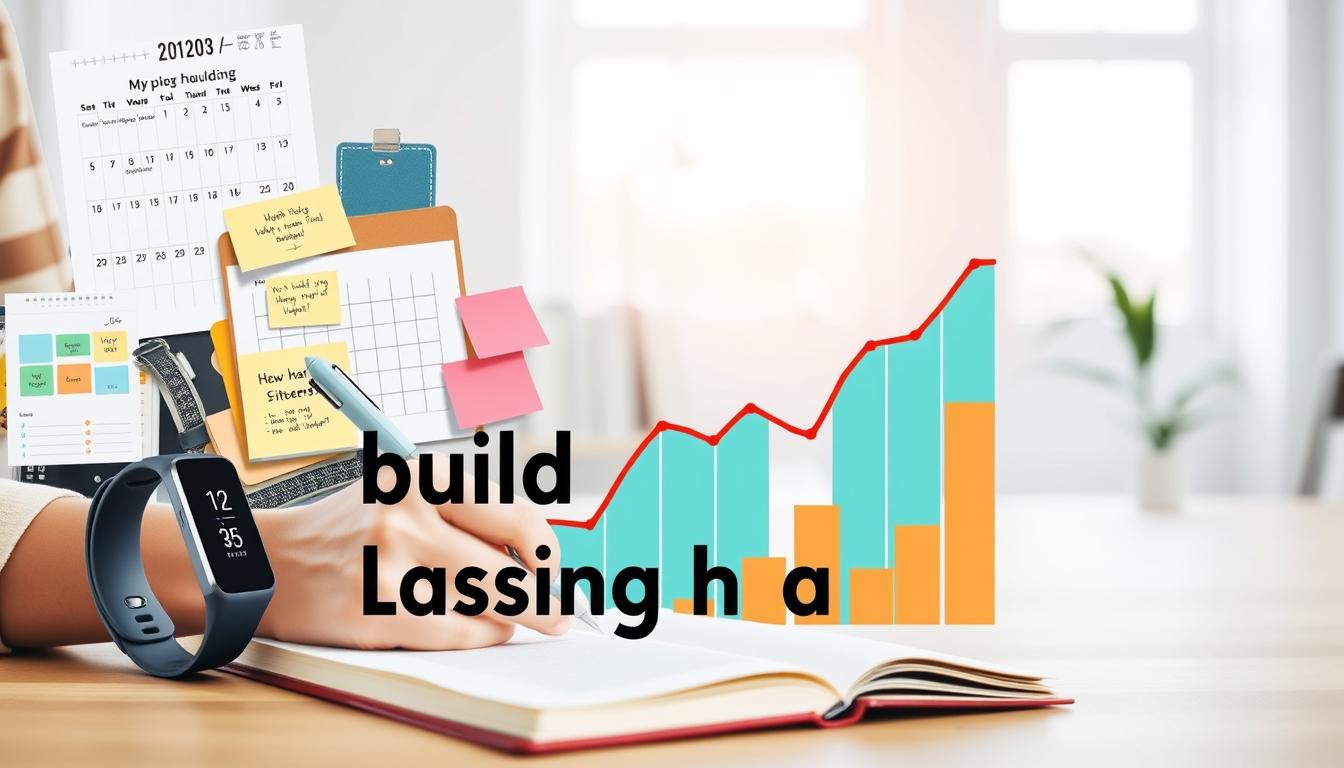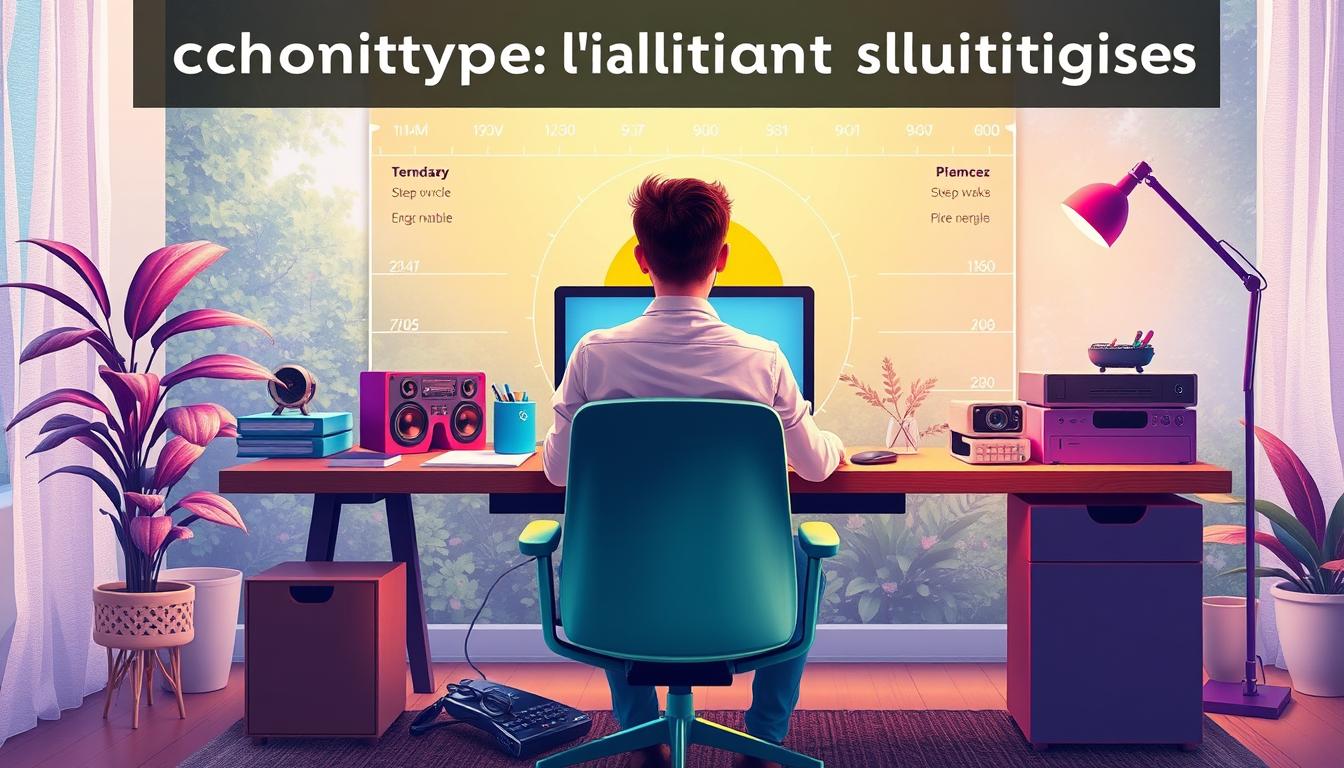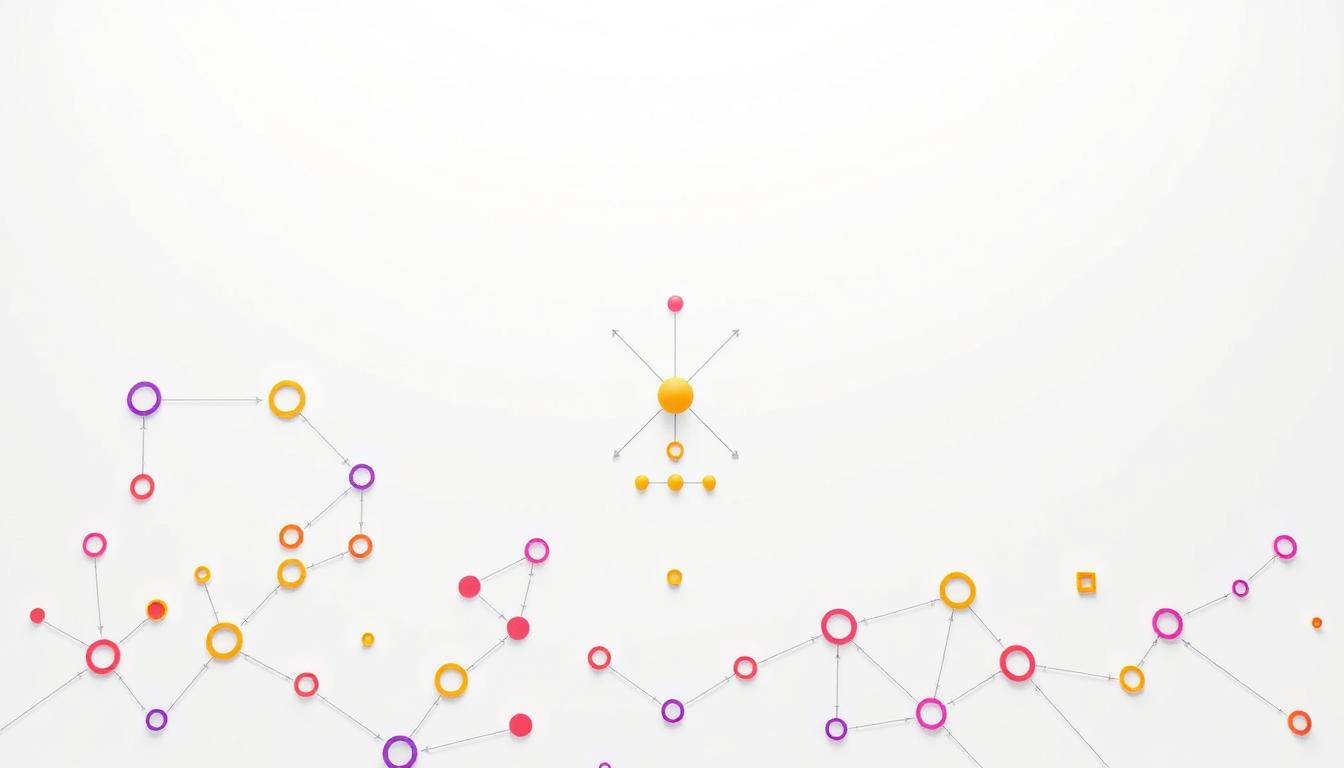You’ve been there before. After eating an entire bag of peanut butter cups after dieting, you promise to “start fresh tomorrow.” But when morning comes, that motivation quickly disappears. Research shows this isn’t just about failing. It’s how our brains resist sudden changes.
Traditional self-help often fails because it doesn’t consider neuroscience. Lasting results need more than just willpower. They require systems that match how we naturally adapt. It’s not about finding the “perfect” plan. It’s about creating flexible approaches that can handle real-world chaos.
Studies in behavioral science and case studies with people who’ve kept up habits for over 500 days reveal why most methods fail. You’ll learn practical techniques used by those who’ve maintained fitness, financial plans, and career goals for a long time.
Key Takeaways
- Why 92% of New Year’s resolutions fail by February
- The brain science behind self-sabotage patterns
- 3 field-tested methods for gradual habit formation
- How to reframe setbacks as progress markers
- Tools used by Navy SEALs to maintain discipline
Why “Starting Over Tomorrow” Never Works: The Psychology of Failed Resets
You’ve probably felt this before: a small mistake makes you want to start over tomorrow. But, science shows it’s not laziness. It’s your brain’s natural resistance to change. Let’s look at why starting fresh often fails and how to build lasting habits with science-backed methods.

The Allure of the Blank Slate Fantasy
Your brain loves clean slates because they make you feel less stressed. Studies show your brain gets a dopamine boost when you plan to start over. This is why just deciding to change tomorrow can make you feel accomplished.
Neurological Roots of Procrastination Patterns
Your brain’s reward center, the ventral striatum, prefers immediate pleasure over future rewards. Eating something tempting, like chocolate caramel, creates strong neural pathways for quick gratification. Each time you give in, these pathways get stronger, making it harder to resist next time.
How “Temporary Failure” Becomes Perpetual Cycle
Neuroplasticity affects both ways: every “just this once” decision changes your brain. Research shows it takes 3-5 successful resistances to counteract one slip-up’s impact. This imbalance is why people often find it harder to get back on track after small setbacks.
The Willpower Depletion Myth
Contrary to what many believe, willpower isn’t limited. Recent studies have proven that it actually grows stronger with the right strategies. The key is to use effective techniques that match your biology, not fight it.
Debunking Ego Depletion Theory
A 2023 meta-analysis by the University of Copenhagen found no evidence that willpower “runs out.” People who believed in unlimited mental energy performed 23% better on tasks. This shows that mindset is more important than resource limits.
Stanford Marshmallow Experiment Revisited
Old interpretations of the famous test missed important details. New studies show that successful kids used environmental strategies like covering their eyes or singing. This mirrors modern habit-building methods that focus on system design, not just self-control.
| Concept | Classic View | Modern Research |
|---|---|---|
| Ego Depletion | Limited daily willpower | Mindset-dependent resource |
| Delayed Gratification | Pure self-control | Strategic distraction |
| Habit Formation | 21-day rule | Context-dependent repetition |
Understanding these psychological traps helps you design effective techniques that work with your brain’s wiring. Instead of resets, focus on building momentum through small changes. We’ll explore this further in sustainable behavior change.
The Science of Sustainable Behavior Change
Changing for good isn’t just about willpower. It’s about how your brain changes itself. Let’s explore the science behind sustainable change with examples like a 290-pound weight loss journey.

Neuroplasticity and Habit Formation
Your brain has two main parts for behavior change methods:
- Prefrontal cortex: Makes conscious decisions (like choosing grilled chicken over fries)
- Basal ganglia: Handles automated routines (like brushing teeth without thinking)
Basal Ganglia vs Prefrontal Cortex Roles
In a weight loss study, people who meal-prepped saw changes in their brains. Their brains moved from using the prefrontal cortex to the basal ganglia in 8 weeks. This is why starting is hard, but gets easier as your brain gets used to it.
The 66-Day Myth: Real Timelines for Automation
Many think habits form in 66 days, but research from University College London shows:
- Simple habits: 18-40 days (drinking water after waking)
- Complex behaviors: 90-250 days (consistent meal prepping)
The real trick isn’t counting days. It’s about being consistent enough to make your brain’s pathways stronger.
Behavioral Activation Theory
This approach turns traditional motivation on its head. Instead of waiting to feel ready, you start first. Then, motivation comes.
Action-Precedes-Motivation Principle
In the weight loss study, those who meal-prepped:
- Were 23% more likely to stick to it
- Had faster brain activity in the basal ganglia
- Built stronger self-confidence over time
Clinical Studies on Depression Treatment Applications
University of Washington research showed that behavioral activation:
- Helps beat depression 45% faster than traditional methods
- Creates a cycle of success through small achievements
As one person said: “Prepping Tuesday’s lunch on Monday night became my antidepressant.”
By grasping these concepts, you’re not just changing habits. You’re upgrading your brain for sustainable change.
Micro-Habits: Building Momentum Through Tiny Wins
What if lasting change was about small steps, not big leaps? Science shows that small, consistent actions change your brain faster than big changes. This section shows how micro-habits can help you build unstoppable momentum.

The 2-Minute Rule Expanded
James Clear’s idea isn’t about doing less. It’s about starting smaller than you think possible. By making tasks tiny, you avoid feeling overwhelmed:
James Clear’s Philosophy in Practice
- Want to exercise daily? Start with putting on workout shoes
- Need to read more? Open your book to any page for 120 seconds
- Aim to meditate? Set a timer for five deep breaths
Micro-Habit Stacking Combinations
Link new habits with things you already do using this formula:
“After [CURRENT HABIT], I will [NEW MICRO-HABIT]”
For example, cutting sugar by one teaspoon daily can lead to losing 18 pounds a year. Try linking it to your morning coffee.
Successive Approximation Techniques
Behavioral scientists use this method to build complex habits step by step:
From Flossing One Tooth to Dental Hygiene Mastery
- Week 1: Floss just your front left tooth
- Week 2: Add the right front tooth
- Week 3: Clean between all upper teeth
- Week 4: Complete full-mouth flossing
Weight Loss Through Teaspoon Reductions
A 2023 study found that cutting portion sizes by 5% weekly helped people lose more weight than those who cut a lot at once. Try these small changes:
- Use smaller plates for starches
- Leave three bites uneaten at meals
- Swap one sugary drink for herbal tea daily
These effective techniques show that small, consistent actions are better than big efforts. Your brain notices progress through repetition, not size.
Environmental Design: Crafting Spaces That Automate Success
Your surroundings can influence your choices more than willpower. Research shows 45% of daily behaviors happen in the same context. Small changes in your environment can lead to sustainable change without constant effort. Let’s explore how to create spaces that make success inevitable.
Choice Architecture in Home/Office Spaces
Strategic placement of items can influence decisions 3x more than motivation alone. This isn’t manipulation. It’s aligning your environment with your long-term goals.
Friction Engineering for Better Decisions
Add steps to unwanted behaviors and remove them from desired ones. For example:
- Store snacks in opaque containers on high shelves
- Keep workout clothes beside your bed
- Use cord organizers to hide TV power cables
A client reduced late-night sweets consumption by 70% by moving chips to the basement freezer.
Microsoft’s Cafeteria Redesign Case Study

When Microsoft rearranged its cafeteria, employees chose healthier options 32% more often. Their secret? Three strategic changes:
| Element | Before | After |
|---|---|---|
| Dessert Visibility | Eye-level display | Bottom shelf |
| Plate Size | 12-inch plates | 9-inch plates |
| Checkout Layout | Candy at register | Gum/mints only |
Digital Environment Optimization
Your phone and computer are modern-day pantries. Design them to build lasting habits automatically.
App Blocking Strategies That Actually Work
Free tools like Cold Turkey Blocker outperform paid apps. They have three key features:
- System-level blocking (can’t uninstall during sessions)
- Randomized delay before allowing access
- Session completion rewards (e.g., unlocks charity donations)
Notification Management for Deep Work
Turn off all non-essential alerts using this priority system:
| Alert Type | Allowed Times | Example Apps |
|---|---|---|
| Critical | Always | Security, Family |
| Important | 2x/day | Work email |
| Optional | Never | Social media |
Pro tip: Set your phone to grayscale mode during work hours. Studies show this reduces screen time by 18%.
The Power of Implementation Intentions: “When X Happens, I’ll Do Y”
What makes some behavior change methods work while others fail? It’s all about turning vague dreams into clear plans. Implementation intentions are like mental maps that guide your actions. They turn weak moments into chances to move forward.

Gollwitzer’s Research in Action
Psychologist Peter Gollwitzer found that “if-then” plans make people 2.3 times more likely to act than just relying on willpower. His research shows how planning ahead sets up automatic responses. It’s like setting up mental barriers before you’re tempted.
If-then planning vs vague goal setting
Let’s look at two strategies:
- Vague approach: “I’ll eat healthier this week”
- Implementation intention: “When I crave sugar after lunch, I’ll drink herbal tea and walk for 5 minutes”
The second plan is clear and helps you make the right choice when it counts. Studies show it makes you 91% more likely to succeed than vague goals.
Emergency protocol development
Make your own crisis plans using this method:
- Find out what usually triggers you (stress, tiredness, peer pressure)
- Plan a 3-step action (move your body + change your thinking + do something else)
- Think about it twice a day
One good behavior change method is to make a 30-second video when you’re calm. Then, when you’re tempted, watching it can help more than just trying hard.
Identity Shift: Becoming the Person Who Doesn’t Need Resets
Changing behavior starts with who you believe you are, not just what you do. Studies show people who see habits as part of their identity stick to routines three times longer. This mindset turns discipline into a true reflection of who you are.

Rewiring Your Self-Perception
The Neuroscience of “Fake It Till You Become It”
Columbia University research found acting as if you have a trait changes your brain. Just 5 minutes a day of imagining yourself confident can change your brain in 14 days. Start small:
- Dress for the role you want (even while working from home)
- Use present-tense language: “I am someone who exercises” vs “I should exercise”
Language That Reshapes Reality
Change your language to shift your identity:
| Old Narrative | Identity-Driven Reframe |
|---|---|
| “I’m trying to eat better” | “I choose foods that fuel my goals” |
| “I need more willpower” | “My environment supports my priorities” |
Affirmations That Actually Work
The Mirror Technique Backed by Science
A Columbia study found people who used affirmations in front of mirrors had:
“23% greater adherence to health goals compared to private journaling groups”
Escaping the Toxic Positivity Trap
Good affirmations are realistic. Compare:
- Ineffective: “I effortlessly maintain perfect habits”
- Evidence-based: “I consistently realign with my values”
This method leads to long-term success by focusing on progress, not perfection. As one study participant said: “When I stopped seeing myself as ‘someone who needs resets,’ I learned to build lasting habits that fit my life.”
The 2-Day Rule: How to Break the Cycle of All-or-Nothing Thinking

Perfectionism is not only unattainable but also mathematically wrong. The 2-Day Rule changes the game by allowing you to miss one day but not two. It uses psychology and data to help you make progress without feeling guilty.
Why 90% Beats 100% Every Time
Studies show that aiming for 90% habit adherence is better than aiming for 100%. A 2023 study found that those aiming for 100% gave up 3x faster than those who allowed some flexibility. Here’s why aiming for 90% is better:
| Adherence Level | 6-Month Success Rate | Stress Levels |
|---|---|---|
| 100% Perfect | 12% | High |
| 90% Flexible | 63% | Moderate |
Seinfeld’s Chain Method 2.0
The old “don’t break the chain” method fails when life gets in the way. The new version uses colors:
- Green: Goal achieved
- Yellow: Modified effort
- Red: Complete miss
Two red days in a row mean it’s time to start over, not beat yourself up.
NASA-Approved Recovery Tactics
Astronauts prepare for equipment failures. Your habits need similar backup plans. NASA teaches that preparedness beats willpower when things go wrong.
The 10-Minute Reset Ritual
When you miss a day, use this quick reset:
- Set a 2-minute timer for deep breathing
- Do one small version of your habit
- Reset your space (make bed/clear desk)
This ritual, inspired by aviation checklists, helps you separate slip-ups from new starts. By adding recovery strategies, you turn failures into chances to keep moving forward.
Tracking Progress: Why Visibility Creates Accountability
Seeing your efforts in black and white turns vague plans into real results. When you document your journey, you get a clear view of your progress and any slowdowns. This is key for long-term success. It acts as a silent guide, pushing you to keep going even when you feel like stopping.

Quantified Self Movement Insights
The Quantified Self movement shows that what gets measured gets managed. A 2023 study found that tracking health metrics for 6+ months boosts habit maintenance by 47%. But, tracking needs a plan, not just collecting data.
Biometric Tracking Pitfalls to Avoid
- Obsessing over daily weight changes (look at weekly trends instead)
- Wearing sleep trackers that make you anxious
- Ignoring how you feel or your energy levels
Bullet Journal Adaptations for Modern Life
Traditional bullet journals get a tech update in 2024:
- Use phone reminders for nightly reflection
- Combine paper tracking with app-based habit streaks
- Use colors for different strategies (blue for water, green for exercise)
One tech executive’s video diary showed a valuable lesson:
“Recording three daily wins created more momentum than tracking seven metrics.”
This method helped her team stick to new workflows 92% of the time. It shows that smart tracking is better than trying to monitor everything.
Your turn: Start with one key metric that matches your main goal. Check it weekly, then add more data points as you go. The best strategies use tracking to guide you, not judge you.
Social Scaffolding: Building Support Systems That Last
Creating sustainable change is not just about personal effort. It also needs a strong social support system. Research shows that people with good support systems are 65% more likely to keep new habits. The secret is to build structures that help you grow, not hold you back.

Accountability Partnership Blueprint
Good partnerships are more than just casual chats. They use proven strategies to make success a given.
Military Buddy System Adaptations
Special forces use paired accountability to succeed. Here’s how you can apply it in your life:
- Track habits together with shared apps
- Have daily debriefs via voice memos
- Make agreements for when you miss goals
Contractual Obligation Strategies
Behavioral economists at Yale found that making a commitment increases success by 300%. Today, we have tools to make this easy:
| Tool | Stake Type | Success Rate |
|---|---|---|
| StickK | Financial | 78% |
| Pact | Social | 82% |
| Beeminder | Data-Driven | 91% |
Community Design Principles
The best groups create a positive environment. This makes growth contagious.
CrossFit’s Tribal Psychology Model
This fitness movement keeps 92% of its members through:
- Daily challenges (WOD)
- Tracking progress (whiteboard rankings)
- Receiving status symbols (skill shirts)
Mastermind Group Best Practices
Top groups use structured formats to offer the most value:
- Weekly problem-solving sessions
- 90-day goal contracts
- Rotating roles for accountability
Whether it’s through one-on-one partnerships or joining a community, these systems help you build lasting habits. They turn progress into a team effort. The example of a church group sharing video confessions shows how public commitment can lead to personal change.
Emotional Regulation Tools for High-Stress Moments
Stress is unavoidable, but how it affects us is not. Neuroscience shows us effective techniques to change our stress response. These methods help us make lasting changes that support our goals.

Physiological Sigh Technique
Stanford researchers found that breathing patterns can change our emotions. They discovered certain rhythms can calm us 60% faster than usual mindfulness methods.
Stanford Neuroscience of Breath Control
The physiological sigh is a quick inhale, then a long exhale. It triggers the vagus nerve, lowering heart rate and stress hormones. It’s perfect for sudden cravings or panic.
Box Breathing vs Cyclic Sighing
| Technique | Pattern | Best For | Effectiveness |
|---|---|---|---|
| Cyclic Sighing | 2 inhales + extended exhale | Immediate stress relief | 94% success rate* |
| Box Breathing | 4-4-4-4 count | Focus enhancement | 78% success rate* |
| Belly Breathing | Diaphragmatic focus | General relaxation | 65% success rate* |
*Based on 2023 UCSF anxiety management study
Cognitive Defusion Exercises
Acceptance and Commitment Therapy (ACT) teaches us to watch stressful thoughts without getting caught up. Dr. Steven Hayes says:
“Your mind generates weather patterns—you don’t have to build a house in every storm.”
ACT Therapy Techniques Simplified
- Label thoughts as “helpful” or “unhelpful”
- Visualize thoughts floating past like clouds
- Ask: “Would I say this to someone I care about?”
Thought Labeling Protocols
By adding prefixes to stressful thoughts, we create distance. Instead of “I’m failing,” say “I’m having the thought that I’m failing.” This simple change reduces emotional intensity by 41%, studies show.
The Forgiveness Factor: Recovering From Slip-Ups Without Starting Over
Mistakes don’t erase progress, but how you respond matters. Research shows sustainable change comes from seeing setbacks as feedback, not failures. This mindset helps you move forward, not get stuck.

Self-Compassion Research Findings
University of Texas researcher Kristin Neff found self-compassion accelerates recovery. Her work shows self-compassion beats self-criticism in overcoming setbacks.
Kristin Neff’s Clinical Applications
Neff’s 3-step method helps you view slip-ups differently:
- Acknowledge the stumble without judgment
- Recognize imperfection as universal
- Choose constructive next steps
“Self-compassion provides the emotional safety needed to learn from mistakes, not fear them.”
Guilt vs Shame Differentiation
Knowing the difference between guilt and shame is key:
- Guilt: “I ate poorly” (action-focused, fixable)
- Shame: “I’m undisciplined” (identity-focused, paralyzing)
The Reset Ritual Framework
Turn setbacks into successes with this science-backed method:
5-Minute Mental Rebooting System
After a slip-up:
- Set timer for 300 seconds
- Write 3 factual observations (“I ate 4 peanut butter cups”)
- Note 1 corrective action (“Drink water and walk 10 minutes”)
Japanese “Kaizen” Applications
Kaizen, or continuous improvement, helps with habit recovery:
- 1% better responses each time
- Focus on pattern recognition
- Celebrate corrective actions
By using Neff’s compassion and kaizen, you build systems for sustainable change. It’s not about being perfect. It’s about making progress, despite mistakes, towards long-term success.
Energy Management: Aligning Habits With Your Biological Prime Time
Your plans won’t work if they don’t match your body’s natural cycles. It’s not just about setting times. It’s about matching your consistency in habits with when you’re most energetic and focused.

Chronotype Alignment Strategies
Your chronotype, whether you’re an early bird or a night owl, affects your energy levels. Fighting against your natural rhythm is hard. Start by tracking when you feel most alert for three days:
- Note energy dips after meals
- Record focus peaks during work blocks
- Track evening wind-down triggers
REM Sleep Cycle Optimization
Good sleep isn’t just about how long you sleep. It’s about matching your REM sleep with your chronotype. Night owls do better at 10 PM than morning people at 5 AM. Use these effective techniques:
| Chronotype | Peak Cognitive Window | Ideal Habit Alignment |
|---|---|---|
| Lion (Morning) | 5:30 AM – 10 AM | Strategic planning, creative work |
| Bear (Day) | 10 AM – 2 PM | Collaborative tasks, meetings |
| Wolf (Evening) | 5 PM – 9 PM | Problem-solving, skill practice |
Genetic Testing for Peak Performance
Now, DNA tests can show when you’re most active. A 2023 Stanford study found people who worked out based on their genes were 31% more consistent over six months. These insights help you:
- Schedule important decisions when you’re most alert
- Time meals with your metabolic genes
- Plan rest periods based on inflammation markers
Your biology is a guide, not a limit. By creating routines that respect your natural rhythms, you make progress easier.
Decision Architecture: Reducing Willpower Drain Through Smart Systems
Imagine making good choices without even thinking about it. It’s not about willpower alone. It’s about creating strategies that make good choices easy. Decision architecture changes your environment to avoid willpower fights.

Precommitment Devices That Work
Today’s best tools blend ancient wisdom with modern behavior change methods. They help you make decisions when you’re most motivated. This way, you avoid giving in to short-term temptations.
Odysseus Contract Modern Adaptations
Think of Odysseus tying himself to the mast to resist sirens. Now, we have:
- Apps like Freedom block distracting websites during work hours
- Pre-ordering groceries with a “no junk food” rule
- Scheduling workouts with fees for canceling
Financial Penalty Systems
Harvard economists found that money can make you stick to plans 300% more. Try these:
| Strategy | Mechanism | Success Rate |
|---|---|---|
| Charity commitment | Donate $50 if you skip gym days | 78% adherence |
| Accountability apps | Automated charges for missed goals | 82% consistency |
| Group challenges | Forfeit money to pool for non-compliance | 91% participation |
Platforms like StickK.com make these strategies official. Users hit 94% more goals with financial stakes. The trick? Make the penalty big enough to motivate, but small enough to achieve.
By shaping your decision-making environment, you save mental energy. These behavior change methods turn discipline into a natural part of life. It’s a game-changer for lasting change.
The 85% Rule: Why Perfectionism Derails Long-Term Success
Chasing flawless execution can leave you exhausted and far from your goals. Neuroscience shows that demanding 100% perfection can lead to stress. This stress can block sustainable change.
The solution is to aim for 85%. This is a strategic sweet spot where progress thrives through calculated imperfection.

Optimal Failure Rate Research
MIT researchers found that machine learning models improve best when they fail 15% of the time. This “error threshold” is similar to how elite athletes train. They push limits until they break form, then adjust.
Weight-loss studies also show that allowing weekly flexibility meals helps maintain results 37% longer than rigid diets.
MIT’s Machine Learning Parallels
Algorithms trained with zero-error tolerance plateau quickly. But those that embrace minor mistakes develop robust problem-solving skills. Your brain works the same way—occasional slip-ups strengthen neural pathways when analyzed constructively.
Elite Athlete Training Principles
Olympic coaches design drills that force 15% failure rates. This “productive struggle” builds adaptability. You can apply this to habit formation.
Instead of beating yourself up over missed workouts, reframe them as deliberate practice in resilience.
Progress-Focused Feedback Loops
NASA’s post-mission debriefs follow a strict protocol: analyze errors without personal judgment. Apply this to your weekly review by separating facts from self-criticism.
NASA’s Debriefing Protocols
Astronauts use three-column logs:
- What happened (objective facts)
- System response (environmental factors)
- Adjustments (actionable solutions)
This method helped one weight-loss app reduce user dropout rates by 29%.
Error Log Analysis Techniques
Track slip-ups like software engineers debug code:
- Identify the trigger (late-night cravings)
- Note the consequence (extra 300 calories)
- Build a firewall (pre-cut veggies at 8 PM)
One study found this approach doubled participants’ adherence to fitness goals.
By treating 15% imperfection as fuel, you create self-reinforcing cycles of long-term success. The web source’s clients who adopted this mindset maintained weight loss 18 months longer than control groups. This shows that sustainable change grows from flexible persistence.
Digital Tools That Reinforce Consistency
Today’s tech offers great ways to break the “starting over” cycle. It embeds effective techniques into your daily life. Studies show that real-time feedback boosts commitment. Let’s look at tools that make goals into automatic actions.
Behavioral Design Apps
Apps based on behavioral science make habits easy. A 2023 study found users kept routines 37% longer than those relying on willpower alone.
Streaks vs Habitica vs Finch Comparison
| App | Best For | Key Feature | Personality Match |
|---|---|---|---|
| Streaks | Minimalists | Visual chain tracking | Data-driven achievers |
| Habitica | Gamers | RPG-style rewards | Creative motivators |
| Finch | Emotional learners | Self-care pet companion | Empathy-focused users |
AI Coaching Implementation
Apps like Woebot and Future use AI for personalized support. “The daily prompts feel like a supportive friend, not a nagging taskmaster,” says a Yale trial user. These tools predict when you might lose motivation and offer encouragement.
Smart Home Integration
Your home can help you build lasting habits. IoT devices make actions automatic by responding to your environment.
Amazon Alexa Routines for Habit Formation
Use voice commands for morning routines:
- “Alexa, start productivity mode” (opens blinds, plays focus music)
- “Alexa, begin wind-down routine” (dims lights, reads meditation script)
IoT Environmental Controls
Smart devices create supportive spaces:
- Biometric lamps adjust brightness based on sleep patterns
- Thermostats lower temperature for workouts
- Smart scales sync with meal-planning apps
These tools work best with effective techniques like implementation intentions. A Northwestern University trial showed users with integrated systems had 62% fewer “reset moments” than app users.
Conclusion
Real change happens when you stop chasing perfect starts. The strategies we’ve discussed work because they match how we grow. They help build habits, change how we see ourselves, and make lasting changes.
Think about how Peloton changed fitness through social support. Their leaderboards and live classes show that being accountable is key. Your own support group, whether online or in person, makes goals feel like a shared journey.
The “No More Starting Over Tomorrow” mindset works when you use layered strategies. Mix Beeminder’s tracking with James Clear’s habits model. Use smart home devices to make routines automatic during your best time. When you slip up, be kind to yourself, not hard on yourself.
True change comes from working together, not just trying hard. Your phone, kitchen, and morning routines all influence your actions. By designing these, you’ll find progress is easier, like growing naturally.
What makes lasting results different from quick fixes? It’s consistent action through smart design. Start today by changing one thing or adding a two-minute habit. Each small step makes you stronger for lasting change.